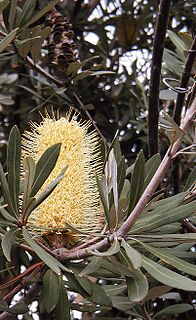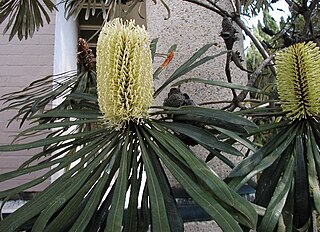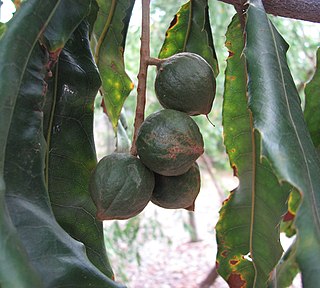
Clematis is a genus of about 300 species within the buttercup family, Ranunculaceae. Their garden hybrids have been popular among gardeners, beginning with Clematis × jackmanii, a garden standby since 1862; more hybrid cultivars are being produced constantly. They are mainly of Chinese and Japanese origin. Most species are known as clematis in English, while some are also known as traveller's joy, a name invented for the sole British native, C. vitalba, by the herbalist John Gerard; virgin's bower for C. terniflora, C. virginiana, and C. viticella; old man's beard, applied to several with prominent seedheads; leather flower for those with fleshy petals; or vase vine for the North American Clematis viorna.

Dryas is a genus of perennial cushion-forming evergreen dwarf shrubs in the family Rosaceae, native to the arctic and alpine regions of Europe, Asia and North America. The genus is named after the dryads, the tree nymphs of ancient Greek mythology. The classification of Dryas within the Rosaceae has been unclear. The genus was formerly placed in the subfamily Rosoideae, but is now placed in subfamily Dryadoideae.

Banksia integrifolia, commonly known as coast banksia, is a species of tree that grows along the east coast of Australia. One of the most widely distributed Banksia species, it occurs between Victoria and Central Queensland in a broad range of habitats, from coastal dunes to mountains. It is highly variable in form, but is most often encountered as a tree up to 25 metres (82 ft) in height. Its leaves have dark green upper surfaces and white undersides, a contrast that can be striking on windy days.

Banksia aquilonia, commonly known as the northern banksia and jingana, is a tree in the family Proteaceae and is endemic to north Queensland on Australia's northeastern coastline. With an average height of 8 m (26 ft), it has narrow glossy green leaves up to 20 cm (7.9 in) long and 6 to 10 cm high pale yellow flower spikes, known as inflorescences, appearing in autumn. As the spikes age, their flowers fall off and they develop up to 50 follicles, each of which contains two seeds.

The taxonomy of Banksia integrifolia has a long and complex history, the result of confusion caused by the species' great variability, and similarities with some closely related species. The existence of hybrids between B. integrifolia and related species as well as early attempts to classify the species based on dried specimen material have also contributed to the confusion.

Banksia integrifolia subsp. integrifolia is a subspecies of Banksia integrifolia.

Banksia integrifolia subsp. compar is a subspecies of Banksia integrifolia. It has larger, glossier leaves than other subspecies, and occurs much further north.

Banksia integrifolia subsp. monticola, commonly known as White Mountain banksia, is a subspecies of Banksia integrifolia. Described in 1994, it occurs in the Blue Mountains and in northern New South Wales. It contains the largest recorded Banksia trees.

Alex George's taxonomic arrangement of Banksia was the first modern-day arrangement for that genus. First published in 1981 in the classic monograph The genus Banksia L.f. (Proteaceae), it superseded the arrangement of George Bentham, which had stood for over a hundred years. It was overturned in 1996 by Kevin Thiele and Pauline Ladiges, but restored by George in 1999. A recent publication by Austin Mast and Kevin Thiele suggests that it will soon be overturned again.
Eurybia integrifolia, commonly called the thickstem aster, is an herbaceous perennial in the composite family. It is native to the western United States where it grows primarily in the Rocky Mountains, the Great Basin, and the Sierra Nevada in Washington, Idaho, Montana, Wyoming, Utah, Oregon, Nevada, and California.

Macadamia tetraphylla is a tree in the family Proteaceae, native to southern Queensland and northern New South Wales in Australia. Common names include macadamia nut, bauple nut, prickly macadamia, Queensland nut, rough-shelled bush nut and rough-shelled Queensland nut.

Macadamia integrifolia is a small to medium sized tree, growing to 15 metres in height. Native to rainforests in south east Queensland and northern New South Wales, Australia. Common names include macadamia, smooth-shelled macadamia, bush nut, Queensland nut and nut oak.

Tephroseris is a genus of Eurasian and North American plants in the groundsel tribe within the daisy family.

Grevillea integrifolia, commonly known as entire-leaved grevillea, is a shrub that is endemic to the south west of Western Australia.

Tacca chantrieri is a species of flowering plant in the yam family Dioscoreaceae. It is commonly called the black bat flower.

Dryas integrifolia is a species of flowering plant in the rose family known by the common names arctic avens, entireleaf mountain-avens, white mountain-avens, northern white mountain avens, and mountain avens. It is native to northern parts of North America, where it occurs from Alaska across Canada to Greenland. It is a common species of the Arctic and it is probably the most common flowering plant on some of the western Arctic islands.

Tephroseris integrifolia subsp. maritima, also known as the spathulate fleawort or South Stack fleawort, is endemic to Holyhead Island, occurring only around South Stack. It is a subspecies of the field fleawort Tephroseris integrifolia.

Seringia integrifolia is a shrub of the family Malvaceae native to inland Australia in New South Wales, South Australia, Western Australia, Queensland, and the Northern Territory.

Zamia integrifolia is a small, tough, woody cycad native to the southeast United States, the Bahamas, Cuba, the Cayman Islands, Hispaniola, and Puerto Rico. The species is possibly extinct in Puerto Rico and Haiti.
Casselia is a small genus of flowering plants in the verbena family (Verbenaceae) first named in 1823. Plants in the genus Casselia are native to South America.
















